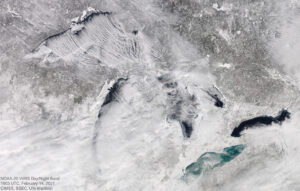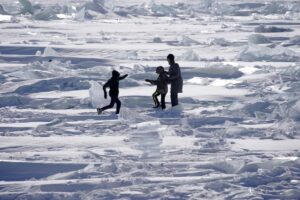Until this recent frigid arctic air outbreak, the Great Lakes were experiencing one of the mildest winters on record
National Oceanic and Atmospheric Administration (NOAA) monitors and reports on the ice coverage of the Great Lakes. NOAA reports total coverage of the Great Lakes is standing at about 32% as of Feb. 12. Historically, much of the major freezing happens in February.

On Feb. 12, the average concentration of ice on Lake Superior was 23%. Lake Michigan’s ice coverage is currently at 27.9%, and Lake Huron’s coverage is 37.9% at this time. The past week has seen significant ice growth, nowhere more apparent than on Lake Erie, the shallowest of all of the Great Lakes, where the ice coverage is currently at 73.9%. Finally, Lake Ontario ice coverage is 11.6%.
The 2021 ice cover of 32%, the maximum coverage this winter, is significantly lower than the long-term average maximum coverage of 53%. The 2021 amount is higher than the 2017 and 2020 maximums (both about 19.5%) and much lower than the 2018 maximum of 70% and the 2019 maximum of 81%. While there is a large annual variability, across all the Great Lakes the annual maximum ice cover is, on average, 22% lower than it was a half-century ago.
Freezing first occurs along the shoreline, where the water is shallow. Cracks can form in the ice and high winds can push ice floes further from shore. On Feb. 6, 66 people, mostly ice fisherman, had to be rescued from an ice floe on Lake Michigan.
Steve Ackerman and Jonathan Martin, professors in the UW-Madison department of atmospheric and oceanic sciences, are guests on WHA radio (970 AM) at 11:45 a.m. the last Monday of each month.


